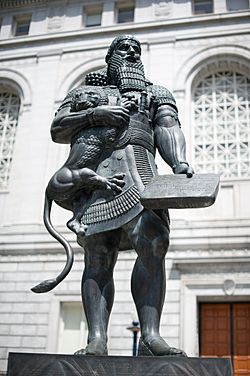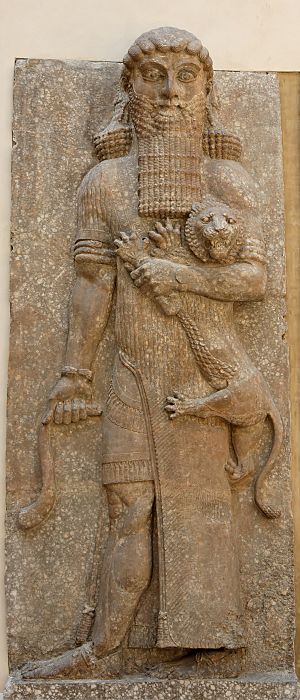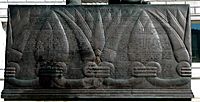Statue of Ashurbanipal (San Francisco) facts for kids
Quick facts for kids Ashurbanipal |
|
|---|---|

Ashurbanipal in April 2011
|
|
| Artist | Fred Parhad |
| Year | 1987–1988 |
| Type | Sculpture |
| Medium | Bronze |
| Subject | Ashurbanipal |
| Dimensions | 4.6 m (15 ft) |
| Weight | ~1,800 lb (820 kg) |
| Location | San Francisco, California, United States |
| 37°46′47″N 122°24′57″W / 37.77973°N 122.415934°W | |
| Owner | Administered by the City and County of San Francisco and the San Francisco Arts Commission |
The Ashurbanipal statue is a large bronze sculpture by Fred Parhad. He is an artist with Assyrian family roots. You can find this statue in the Civic Center area of San Francisco, California, in the United States.
The statue is about 15-foot (4.6 m) tall. It shows Ashurbanipal, who was a famous Assyrian king. The Assyrian Foundation for the Arts asked for this statue to be made. They gave it to the City of San Francisco in 1988. It was a gift from the Assyrian people. The sculpture cost around $100,000. It was the first "sizable" bronze statue of King Ashurbanipal. The City and County of San Francisco and the San Francisco Arts Commission take care of it.
Some local Assyrians were not happy with the statue. They felt it was not quite right. They thought it was strange to show Ashurbanipal holding a clay tablet and a lion. They also questioned him wearing a skirt. Critics believed the statue looked more like Sumerian king Gilgamesh. A scholar named Maureen Gallery Kovacs thought it looked like neither. She believed it was a general Mesopotamian "protective figure." Fred Parhad, the artist, said his work was mostly accurate. But he also said he used some artistic freedom.
Creating the Ashurbanipal Statue
The Ashurbanipal statue was designed by Fred Parhad. He was born in Iraq and is of Assyrian descent. Parhad decided not to study art formally at the University of California, Berkeley. Instead, he moved to New York. There, the Metropolitan Museum of Art let him study their collection of ancient Assyrian art.
The Assyrian Foundation for the Arts asked Parhad to create the statue. Their president, Narsai David, led this project. The Assyrian Universal Alliance Foundation also says they helped with the project. Money for the statue was collected from Assyrians all over the United States.
In 1987, a newspaper called The Telegraph reported on the statue. They said it cost $100,000. It was the first "sizable" bronze statue of Ashurbanipal. The statue was given to San Francisco on May 29, 1988. It was first shown at the entrance to the Asian Art Museum on Van Ness Avenue.
Today, the statue stands on Fulton Street. It is between the Main Library and the Asian Art Museum. This area is part of the city's Civic Center. The City and County of San Francisco and the San Francisco Arts Commission manage the statue.
The Smithsonian Institution lists Frank Tomsick as the architect for the statue's setup. MBT Associates was the architectural company. The Smithsonian's Save Outdoor Sculpture! program checked on Ashurbanipal in 1992. In 1996, there were plans for a pedestrian area in the Civic Center. One planner suggested an Assyrian garden near the statue. This garden would have lotus flowers, pomegranate trees, and reeds.
What the Statue Looks Like
The statue is made of bronze and has a green-brown color called patina. It is 8-foot (2.4 m) tall. It stands on a base and a plinth, making its total height 15 feet (4.6 m). The statue weighs about 1,800 pounds (820 kg).
It shows Ashurbanipal, the Assyrian king. He is famous for building the Library of Ashurbanipal. This was the first and largest library in Nineveh. The king in the statue has a beard. He wears earrings and a tunic. In one hand, he holds a clay tablet. With his other hand, he holds a lion cub close to his chest.
The Historical Marker Database says what is written on the clay tablet. It says: "Peace unto heaven and earth / Peace unto countries and cities / Peace unto the dwellers in all lands / This is the statue presented to the City of San Francisco by the Assyrian people in the 210th year of America's sovereignty".
The statue is "larger-than-life" and shows the king standing. It is on a plinth with a lotus flower design. The base is made of concrete and has a special coating to prevent graffiti. The base also has rosettes and a bronze plaque.
One writing below the statue shows the tablet's message in English. It also shows it in Akkadian cuneiform and Aramaic. Above this, it says "Ashurbanipal, King of Assyria, 669–627 B.C." Below, it says "Dedicated May 29, 1988." Both are in English. Another writing below the statue lists who gave the gift. It says, "Presented to the City of San Francisco by the Assyrian Foundation for the Arts through donations of American Assyrian Association of San Francisco / Assyrian American National Federation." Then, it lists the names of people who donated. In December 2010, the San Francisco Chronicle newspaper reported that a large plaque from the sculpture was missing.
See also
 In Spanish: Estatua de Asurbanipal (San Francisco) para niños
In Spanish: Estatua de Asurbanipal (San Francisco) para niños




